Rocket Lab’s Electron will launch seven satellites on this flight, including the Japanese shooting-star satellite ALE-2. The cubic craft was built by Tokyo-based company Astro Live Experiences as part of its Sky Canvas project.
ALE-2 is 24in square, weighs 165lbs and is packed with 400 0.4in spheres built to burn up high in Earth’s atmosphere, creating a stunning shooting star spectacle.
With this launch, we are a step closer to realising the man-made shooting star
Astro Live Experiences CEO Lena Okajima
Astro Live Experiences CEO Lena Okajima wrote in a statement: “With this launch, we are a step closer to realising the man-made shooting star.
“Please look forward to the world’s first demonstration we are aiming for in 2020, which will be a major milestone for ALE.”
The Japanese company’s first satellite, ALE-1, launched in January aboard an Epsilon rocket.
The craft is also scheduled to deploy its cutting-edge sky pellets again in 2020, after some on-orbit tests.
The artificial meteors will travel more slowly through Earth’s sky than real ones and will thus remain visible longer — three to 10 seconds, ALE scientists revealed.
Real meteors enter our atmosphere at speeds ranging from 25,000mph (40,233kmh) to 160,000mph (25,7495kmh)
The pellets are designed to completely incinerate between 37 and 50 miles (60 to 80km) over Earth, meaning they will pose no threat to people on the ground or planes in the air.
DON’T MISS
NASA supercomputer creates millions of ‘Universes’ [INTERVIEW]
Hubble snaps galaxy ‘like a portal to another dimension’ [PICTURES]
Shadow land: ‘Alien life can exist in 2D universe’ [ANALYSIS]
READ MORE
-
NASA reveals Taku Glacier is melting 80 YEARS ahead of schedule
ALE envisions creating artificial showers for global events, such as the opening ceremony of the 2020 Summer Olympics in Tokyo.
The synthetic shooting stars will be seen across a 125 mile-wide (200km) area.
Rocket Lab’s 10th launch, dubbed Running Out of Fingers and sixth of this year alone.
The space company plans to ramp-up its operation considerably, eventually launching Electron rockets every week, or even faster.
Rocket Lab consequently wishes to start recovering and reusing the first stage of the two-stage, 57ft-tall (17m) Electron, a craft capable of ferrying up to 500lbs of cargo into orbit.
The other six satellites launching on the Electron later this month including ATL-1, a Hungarian craft testing a new thermal isolation material.
Accompanying that is FossaSat-1, a Spanish communications satellite small enough to fit in the palm of your hand.
NOOR 1A and NOOR 1B are additional communication satellites operated by the Stara Space.
SMOG-P is a payload designed by students at Hungary’s Budapest University of Technology and Economics to measure electromagnetic pollution.
And TRSI Sat, operated by ACME AtronOmatic will provide flight-tracking services to the aviation community.
Source: Read Full Article







